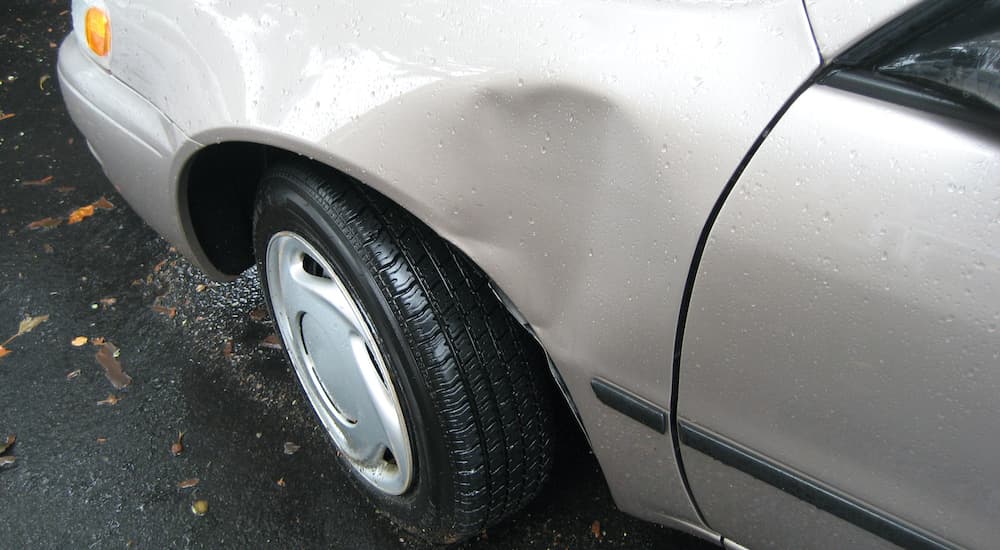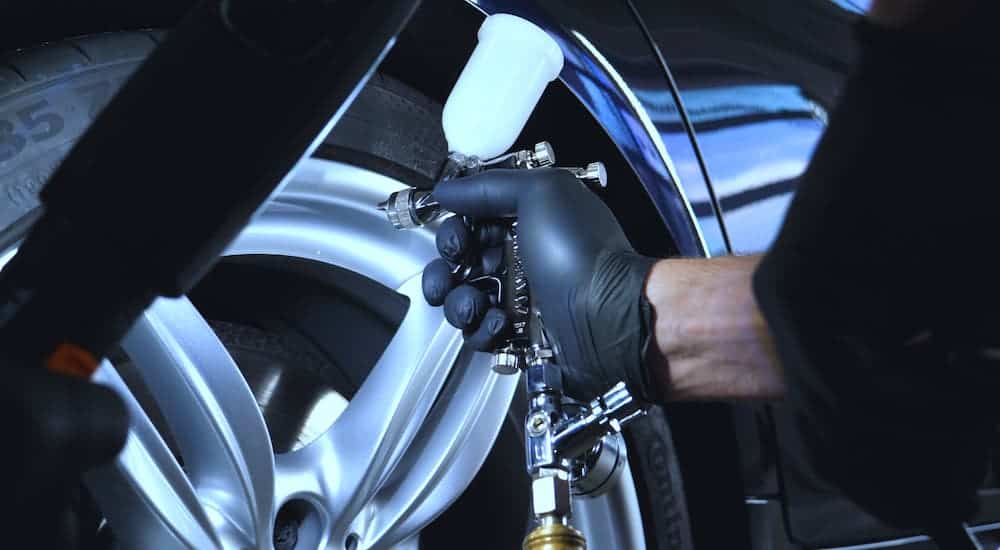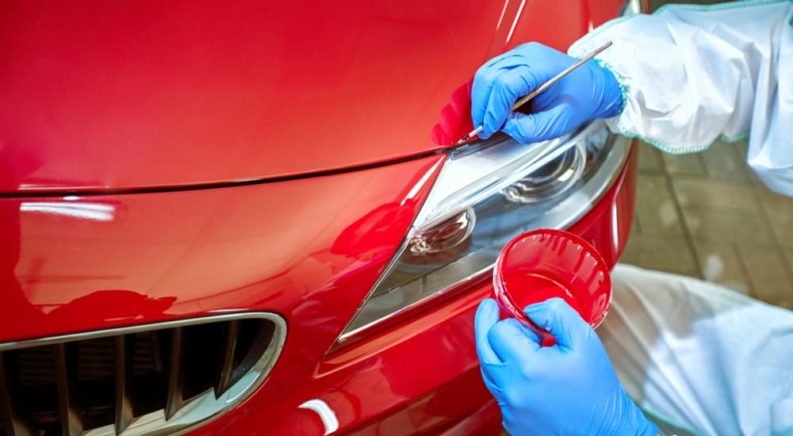Imagine you’ve just picked up a new vehicle. Before sliding behind the wheel, you take a slow walk around your car, admiring the perfect paint and sculpted bodywork. Somewhere in the back of your mind, you know this is the best your car will ever look: it’s pristine. Flash forward to a few months later, and you notice something white along the side panel. “Is that paint?” you think. Then you remember – you drove past a crew that was restriping the road. “So much for my perfect car,” you grumble.
For car lovers, there’s no better feeling than knowing you’re driving a blemish-free car. That pride of ownership shows with your commitment to twice weekly car washes and your enviable commitment to cleaning out the cabin every day to avoid the slow accumulation of stuff that often ends up in the car. But when it comes to figuring out how to get striping paint (road paint) off your vehicle, the complexity factor goes through the roof. Who can you trust for exterior paint repairs, and how much can you expect to pay?
Cosmetic repairs to your vehicle’s exterior don’t have to cost thousands. You shouldn’t have to worry about mismatched paint or obvious buff jobs that threaten to lower your car’s value. Your best bet is to find a reputable body shop with experience performing the types of repairs you need. From door dings to minor scratches and everything in between, restoring your car to its original pristine condition is easier than you might think.
Paint Transfers and Splatter
If you’ve ever driven by a road crew laying down new striping and held your breath, you’re justified. Paint transfer happens all the time, and by the time you get where you’re going, the paint is probably dry. Avoid attempting to remove the paint yourself using your fingernail or a scraping tool because you could damage the clear coat in the process. You should also skip chemical solvents or any abrasive cleaner.
Your first step is a car wash – ideally one with high-pressure washing capabilities. If the paint is new and hasn’t fully dried, a high-pressure wash could remove it. Your next step is a tried-and-true solution: WD-40. Apply a coating to the affected areas and let it sit for a couple of hours, then rinse it off. Repeat this step a few times if the paint is stubborn. If the paint still won’t budge, coat the paint with Vaseline (petroleum jelly) and leave it overnight. Head back to the high-pressure car wash and give it a good rinse. This should remove the paint for good.
Most Department of Transportation (DOT) agencies use water-based paint for road striping. Unless the paint sits on your car for more than a few days, removing yourself should be easy. The DOT recommends applying a coat of wax to your car after removing road striping paint to remove any remaining residue. If paint ends up in your wheel wells where the finish is flat, try rubbing alcohol to soften the paint build-up and go over the area with a wet rag.
Fixing Those Annoying Door Dings
As parking spaces shrink, so does your proximity to other motorists who might be a little careless. One uncontrolled car door swing could lead to a visible dent on your previously perfect sheet metal. Maybe you’re the careless one, and you backed up a little too far last time and experienced the dreaded “bumper kiss.” Regardless, you’re looking at an ugly dent that’s catching the sunlight in all the wrong ways.
Fixing these little golf ball-sized dings is almost always a minor repair. You shouldn’t have to replace entire panels or go without your vehicle for days while it sits at the body shop. In fact, some handy drivers already have the tools they need right in their garage to DIY their door ding repair. Whether you’re handy or need a little assistance, if your car was the victim of a wayward shopping cart, a paintless dent removal company can likely restore it to pre-impact condition for less than a couple hundred bucks.
Your first step is to assess the damage. If the paint is cracked, a paintless dent repair service can’t help you. Where is the damage? Is there a dent in your plastic bumper, or did a small object hit your aluminum hood? Start by inspecting the area. Once you know the damage’s severity, contact two or three companies and gather estimates. The first company you call may not diagnose the issue correctly, so be sure to get at least two opinions, if not more.
Small dents are pretty easy to repair. You can find dent repair kits at the local auto store. These tools work by “popping” the ding back into place using suction. For some intrepid DIY’ers, a plunger and some water might do the trick but don’t count on it. Plastic bumpers can sometimes be repaired by softening the area with a hair dryer, but it takes a steady hand and plenty of skill to pull it off. At the end of the day, for most drivers, trusting the repair to a qualified dent repair company is the best solution.

Fixing Scratches and Larger Dents
Sometimes, the damage your car sustains is more serious than a quick ding repair or trip through the car wash. In those instances, it is critical to find a reputable body shop or dealership to perform an inspection and make recommendations for a repair that ensures your car is restored to its original condition. Some body shops use cheap OEM replacement parts that can harm your car’s resale value. Don’t jump at the cheapest estimate – it could lead to more costly issues later.
If your car is newer, consider bringing it to the dealer you bought it from if that dealer has an on-site body shop. If they don’t perform in-house bodywork, ask for a referral. Repairing body panel damage isn’t a service you want to shop for; however, the least expensive estimate won’t necessarily come from the least experienced shop. Most reputable repair shops don’t offer discounts and won’t negotiate.
Regardless of your vehicle’s age, requesting genuine OEM replacement parts is always advisable. Depending on the extent of the damage, your repair might encompass other vehicle components. When a body shop uses less expensive OEM parts, the potential for issues down the line increases exponentially. Cheap parts not built for your specific vehicle could lead to phantom rattles or noticeable mismatches between body panel seams.
Protect Your Vehicle’s Exterior Paint From Road Hazards
You’ve invested thousands in your new or used vehicle, so it’s important to take steps to protect it. Short of coating your car in bubble wrap or leaving it in the garage, you can’t 100 percent ensure that dings and dents won’t happen, but a few preemptive steps could save you time and money in the long run. First, park your vehicle away from other cars. Sure, you may have to walk a little farther, but choosing a spot in the back of the lot decreases the chances of sustaining a door ding.
Passive damage, like fading from the sun or damage from inclement weather like hail, can easily be avoided by garaging your car. If that’s not possible, consider purchasing a car cover. When you encounter road crews restriping on your route, run your car through the car wash as a preventative measure. Regularly inspect the exterior and be on the lookout for parking lots where shopping carts are present. A few simple steps can help you keep your vehicle’s exterior looking brand new.


